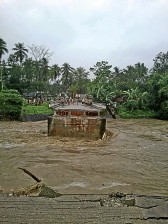
Floodwater with logs and uprooted trees destroyed the Caraga Bridge in Caraga town, Davao Oriental province, on Sunday morning. The town is now isolated from its neighboring town of Manay in the south and Baganga town in the east. FILE PHOTO
MANILA, Philippines—Despite aid funding gaps in the provinces hit hardest by Typhoon Pablo, the Philippines has shown “a model best practice” for coordination with the international community in responding to a disaster of such magnitude, a senior United Nations humanitarian official said this week as he appealed for more aid for the victims.
Following a recent visit to Mindanao, John Ging, Operations Director at the UN Office for the Coordination of Humanitarian Affairs (UNOCHA), said Thursday that aid coordination seen in the Philippines could serve as a disaster response model for other countries to emulate in the face of major humanitarian emergencies.
“I have to say, in all of the countries that I have visited in this past year, this stands out as a model of best practice where the government and the international community are partnering in a very effective way,” said Ging in a press conference at the UN headquarters on Thursday.
The UNOCHA has been closely watching and assessing disaster response to typhoon-affected provinces in Mindanao, monitoring the distribution of aid from the government and international and local donors.
The disaster killed more than a thousand people and left nearly a million homeless in hard-hit provinces including Compostela Valley and Davao Oriental. Both foreign and local aid sent to the area was mainly coordinated by the Department of Social Welfare and Development.
During the March 28 press conference, Ging called on donors to continue supporting relief efforts in Mindanao, saying it was important to make sure that the Philippines would “not fall off the international radar screen.” He noted that funds were still not enough to provide for urgent food, shelter, water and other essential needs in affected provinces.
He appealed to the donor community “not to forget the people who have suffered incredibly due to this natural disaster.”
“We are making a very real difference, sustainable difference, through the effort under way,” said Ging added.
He said only 34 percent of the UN’s $112 million (P4.5 billion) aid appeal had been fulfilled nearly four months since the deadly typhoon hit Mindanao, with some $37.5 million (P1.5 billion) in aid so far received from international donors.
“The scale of this natural disaster in Mindanao is unprecedented. Our job now is to ensure that the international community remains focused to assist the Government for whatever length of time is required,” Ging said in a separate statement released by UNOCHA.
During his visit, Ging met with local government officials and representatives from international donor organizations and non-government organizations involved in relief efforts. He also travelled to Compostela Valley.
He noted the resilience of Filipinos who carried on despite the disaster: “Despite these challenges, what impresses me the most is the resilience of the survivors of the typhoon. We will do our utmost to ensure that their needs do not fall off the international agenda.”